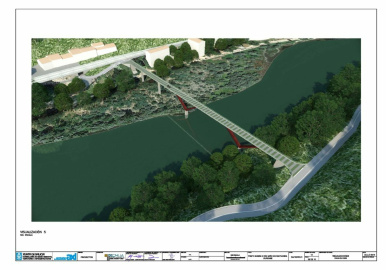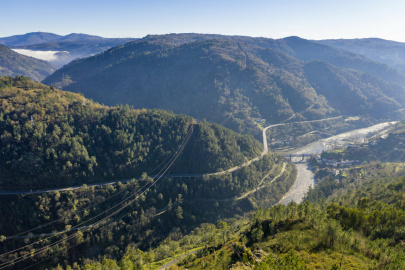
16.9.c Peares - Torrón
We can take advantage of this stop to learn more about the infrastructure that improved connections between the shores of the Sil and Miño Rivers, making Os Peares a very important location between the late 19th century and mid‑20th century.
On our side of the Sil River we can see an enormous pillar about 75 metres high, which has its twin located on the river’s opposite shore. These pillars support the viaduct for the N‑120 highway, which was built in the 1990s to improve safety and reduce travel times between Monforte de Lemos and Ourense.
To our right, we can see the railway bridge that spans the Miño River, as well as the new bridge that crosses the Miño below the point where the Sil River flows into it. To our left, we can see the old bridge that was part of the original N‑120 highway, which has now become the N‑120a.
RAILWAY BRIDGE
The beautiful bridge we see in front of us was built in 1885. It was the final section that had to be completed in order to start up the Monforte de Lemos to Vigo railway line, at kilometre point 027/332.
This bridge is 107 metres long, with three sections that make use of a lattice truss beam design. It was built by a company known as MZOV (Medina to Zamora and Ourense to Vigo Railway Company), as the solution that was needed for the final railway section, where the tracks had to cross the Miño River at its point of confluence with the Sil.
One interesting detail about this bridge is that it was painted black until the year 2004, when Spain’s railway operator RENFE reached an agreement with the local council to give it the blue colour we see today.
BRIDGE OVER THE MIÑO RIVER
This bridge was completed in 2016 and represents the most recent addition to this set of infrastructure elements. It is 193 metres long, and its design features five spans supported by two regular pillars and two V‑shaped pillars, with the larger of those being 64 metres high.
The bridge’s deck is 5.05 metres wide, and because the roads that this bridge connects do not have much traffic and are not used by heavy vehicles, it has been designed for shared use by vehicles and pedestrians.
HISTORIC BRIDGE AT OS PEARES
This historic bridge was designed in 1880, and it features a single span that is 62 metres long, with a deck supported by long steel girders that measure 5 metres across. The original design by Manuel Maese made use of a lattice truss beam system, but the construction company, the Belgian firm Braine Le Compte, successfully proposed a change to the design we see today.
The Sil River’s strong currents and water level variations made construction of this bridge an arduous task, but in early 1888 the scaffolding was finally removed, and after painting the bridge and installing wooden planks for its deck, a successful load test was performed and the bridge was allowed to open in September 1888.
The opening of this bridge also led to a loss of work for the ferry boats that carried passengers and cargo across the Miño and Sil rivers.
 Directions
Directions 

